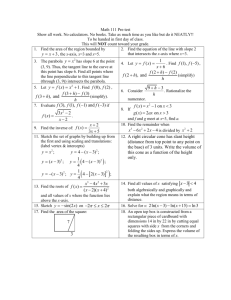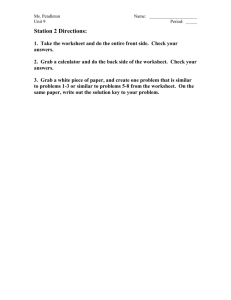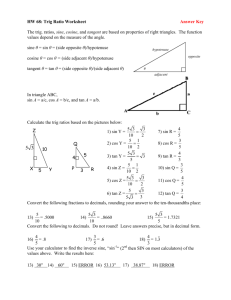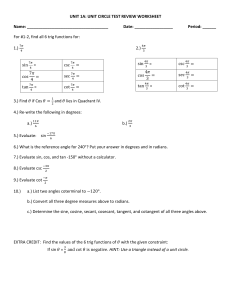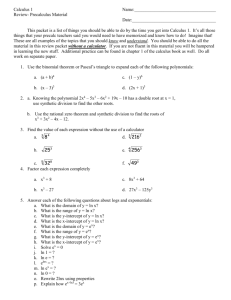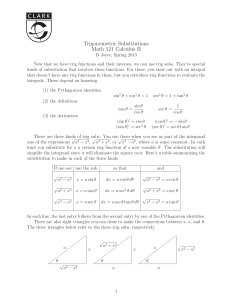Chapter 1: Trigonometric Functions
advertisement
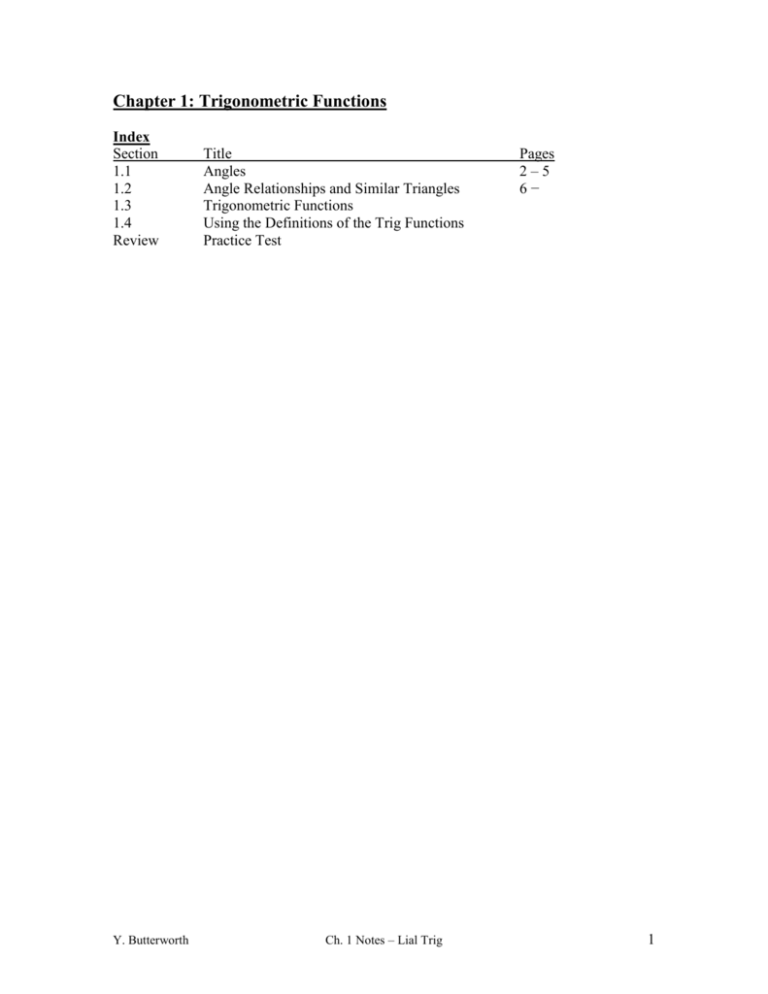
Chapter 1: Trigonometric Functions Index Section 1.1 1.2 1.3 1.4 Review Y. Butterworth Title Angles Angle Relationships and Similar Triangles Trigonometric Functions Using the Definitions of the Trig Functions Practice Test Ch. 1 Notes – Lial Trig Pages 2–5 6− 1 §1,1 Angles Outline Lines Segment Ray Endpoint Angles Positive Negative Initial Side Terminal Side Vertex Types Acute Right Obtuse Straight Complements Supplements Standard Position Quadrant Coterminal Degrees Babylonians 4000 yrs ago 360º complete rotation Minutes (′) – 60 in 1º Seconds (′′) – 3600 in 1º Definitions Associated w/ Lines Line – Determined by two points A and B Notation Line AB Segment – Part of a line between points A&B Segment AB Ray – Portion of a line from point A thru B Ray AB Visualization Endpoint of Ray – The point from which a ray begins Definitions Associated w/ Angles Angle – Two rays with a common endpoint Notation ABC Visualization Vertex – The point in common with the rays Initial Side – The ray that begins the rotation to create an angle Terminal Side – The ray that represents where the rotation of the initial side stopped Positive – An angle created by the initial side rotating counterclockwise Negative – An angle created by the initial side rotating clockwise Y. Butterworth Ch. 1 Notes – Lial Trig 2 Acute – An angle measuring less than 90º Right – An angle measuring exactly 90º Obtuse – An angle greater than 90º but less than 180º Straight – An angle measuring exactly 180º Complementary – Two positive measure angles that sum to 90º Supplementary – Two positive measure angles that sum to 180º Standard Position – An angle with its vertex at the origin and its initial side being the x-axis. Lies in the quadrant where the terminal side lies. y QII Origin = Vertex QIII QI Terminal Side Initial Side QIV Quadrant Angles – An angle in standard position whose terminal side lies on the x or y-axis. 90º, 180º, 270º and so on. Coterminal Angles – Angles that differ by a measure of 360. Find by x + n•360. Y. Butterworth Ch. 1 Notes – Lial Trig 3 x Definitions Associated w/ Degrees Degree – 1/360 of a complete rotation of a ray. Notation 1º Visualization Minute – There are 60 minutes in a degree. 1º = 60′ Second – There are 60 seconds in a minute or 3600 seconds in a degree. 1º = 3600′′ Now we will practice the application of the concepts from this section – the application of all the above definitions. Unless starred, the following examples are from Lial’s 9th Edition Trigonometry book. Example: Give the a) complement and b) supplement of an angle measuring 55º. Example: a) Find the measure of the angles. *b) (7t + 4)º (2r)º (2t + 5)º (3r)º *Example: Find the measure of the smaller angle formed by the hands of a clock when it is 8:00. (Hint: Total degrees /12 = ?º per number on clock face) Example: Perform each operation. (Hint: Think about adding/subtracting time or mixed numbers) a) 28º35′ + 63º52′ Y. Butterworth b) 180º − 117º29′ Ch. 1 Notes – Lial Trig 4 Example: a) Find the measure of the least possible positive measure coterminal angle. (Hint: “+” add/subt. mult. of 360º to get between 0º & 360º, “−” less than 360º use a rotation (add 360º) “−” greater than 360º find next mult. bigger than & add) 1106º b) -150º c) -603º *Example: Give 2 positive & 2 negative angles that are coterminal with 75º (Hint: x + n•360º) *Example: Give an expression that will generate all angles coterminal with -35º (Hint: x + n•360º) xample: xample: a) b) c) Sketch 300º in standard position (use an arrow to show rotation) Give the quadrant of the angle Find one positive & one negative coterminal a) b) Sketch the coordinate system and locate (√3, 1) Draw a ray through the point & indicate (w/ an arrow) the std. pos. having least positive measure Find the distance “r” from the origin to the point using r = √ (x1 − x2)2 + (y1 − y2)2 c) Example: Y. Butterworth A wheel makes 270 revolutions per minute. Through how many degrees Ch. 1 Notes – Lial Trig 5 will a point on the edge of the wheel move in 5 sec.? Y. Butterworth Ch. 1 Notes – Lial Trig 6 §1.2 Angle Relationships and Similar Triangles Outline Angles Formed w/ Lines Two Intersecting Lines Vertical = Parallel Lines Cut by Transversal Alternate Interior ’s = Alternate Exterior ’s = Corresponding ’s = Interior ’s = Similar ∆’s Congruent Similar (not reverse) ’s = & Sides in proportion Called Correspondence Corresponding ’s = Corresponding sides proportional ratios = Triangles Sum of ’s = 180º Types of ∆’s Based on ’s Acute (all < 90º) Right (one = 90º) Obtuse (one > 90º) Based on Sides Equilateral (all sides =) Isosceles (2 sides =) Scalene (all side ≠) Vertical ’s Angles across from one another, formed when two lines intersect. 1 3 2 4 Parallel Lines Cut By a Transversal Corresponding ’s – Same side of transversal & ll lines DH F CG D C Alternate Interior ’s – Inside of ll lines & alternate sides of transversal A B H E G F C BH Alternate Exterior ’s– Outside of ll lines & alternate sides of transversal AG DF Example: Interior ’s On Same Side of Transversal CH = 180° B E = 180° Find the measure of ’s 1,2,3&4 1 2 = (9x + 9)° 4 Y. Butterworth 3 = (7x − 5)° Ch. 1 Notes – Lial Trig 7 Triangles A geometric figure (polygon) with three sides. The sum of angles in a triangle is 180°. B ABC C A B Find B. Example: A 48° 61° C Types of ∆’s Based on s Acute – All ’s less than 90° B Types of∆’s Based on Sides Scalene – All sides different lengths B A A C Isosceles – Two sides same lengths B C Right – One is 90° B A C Equilateral – All sides same lengths B C A Obtuse – One is greater than 90° A Example: a) A B C A Classify each by side and ’s b) 8 C B = 135° c) 60° 8 Y. Butterworth C Ch. 1 Notes – Lial Trig 60° 8 Y. Butterworth Ch. 1 Notes – Lial Trig 9 Y. Butterworth Ch. 1 Notes – Lial Trig 10 §1.3 Trigonometric Functions Outline Standard Position x, y & r r = √x2 + y2 6 Trigonometric Functions sine, cosine, tangent, cotangent, secant & cosecant Exact Values vs Approximate Values Exact: Std. Form, x, y & r or Right Triangle opposite, adjacent & hypotenuse Approximate: Calculator in DEG mode Quadrant ’s Unit Circle Drawing w/ Calculator Table p. 27 Standard Position of P (x, y) “r” is hypotenuse “y” is opposite “x” is adjacent r = x2 + y2 (Pythagorean Theorem) r > 0 since it is a distance (an undirected vector meaning it has no direction) Based on the in Standard Position the 6 trigonometric functions can be defined. The names of the 6 functions are sine, cosine, tangent, cotangent, secant and cosecant. Because there are many relationships that exist between the 6 trig f(n) you should get in a habit of thinking about them in a specific order. I’ve gotten used to the following order and I’ll show you some of the important links. sin = opp hyp = y r cos = adj = x hyp r tan = opp adj Y. Butterworth = sin = y cos x x0 cot = adj = opp 1 = cos = x tan sin y sec = hyp adj = 1 cos = r x x0 csc = hyp opp = 1 sin = r y y0 Ch. 1 Notes – Lial Trig y0 11 Note 1: These are the exact values for the 6 trig f(n). A calculator will yield only the approximate values of the functions. Note 2: This is both the definitions from p. 23, their reciprocal identities on p. 30 and relations that don’t tie to the coordinate system (an in standard position). The definitions given in terms of opposite, adjacent and hypotenuse will help in Ch. 2. How to Find the Exact Values of the 6 Trig F(n) Step 1: Draw the in the coordinate system creating a ∆ w/ the terminal side and the xaxis. Step 2: Place θ, x & y and find r (using r = √x2 + y2) Step 3: Use x, y & r w/ definitions to write the exact values of the 6 trig f(n) Note: Once you’ve got sin, cos & tan you’ve got the others due to the reciprocal identitites. Step 4: Simplify (you’ll need to review your radicals) The terminal side of θ in standard position passes through the point given. Find the value for the 6 trig f(n) of each created by the ray passing through the origin and the given point P. (12, 5) b) (8, -6) Example: a) It is important to note that the 6 trig f(n) values change depending on θ’s measure, not upon the point through which r passes. This is because along every ray, there are an infinite number of ordered pairs. Or, said another way, There are many ordered pairs that will create the same ray. x θ O P′ (4, -3) Example: Y. Butterworth y P (8, -6) The ray OP is a portion of the line y = -3/4 x and ∴ P′ also lies on the ray OP. Both points will yield the same values of the 6 trig f(n). For the ray OP shown above, compute sin, cos and tan using P′ (4, -3). Do you see that these 3 (and therefore also cot, sec & csc b/c of the reciprocal identitities) are identical to those computed in the part b of the last example? Ch. 1 Notes – Lial Trig 12 Note: What do you notice about the slope of the ray OP and the tan θ? In general they will always be the same. Now we can extend this idea to the fact that any ray can be described by: Ax + By = 0 where x ≥ 0 or x ≤ 0 Thus we can use a ray’s equation to find the trig f(n) for formed by the terminal side by such a ray. Finding 6 Trig F(n) Given a Ray’s Equation Step 1: Let x = value in the domain and solve for y (finding an ordered pair on the ray) Step 2: Draw the ray with x&y from step 1 and create the right triangle. Step 3: Find r using x & y Step 4: Use the definitions for the 6 trig f(n) to find their exact values Find the exact values fo the 6 Trig F(n) for in standard position if the terminal side is defined by 3x – 2y = 0 and x < 0. Example: Let’s do an example that emphasizes critical thinking and knowing the 6 trig f(n) *Example: Decide if the function or ratio would be positive or negative. [Hint: Think (x, y) values in Quadrants] a) I, sin θ b) II, y/x c) III, cot θ d) IV, r/y Quadrant ’s – The ’s that lie on the axes. 0°, 90°, 180°, 270° & 360° and their multiples x + n • 360 (0, 1) x=0 y=1 r=1 (-1, 0) (1, 0) x = -1 y=0 r=1 x=1 y=0 r=1 x=0 y = -1 r=1 (0, -1) Note: This begins the concept of the unit circle which will be studied in Ch. 3. Y. Butterworth Ch. 1 Notes – Lial Trig 13 Quandrant ’s on x-axis -- 0°, 180° & 360° (or their multiples) X = ±1 Y = 0 in Numerator F(n) = 0 Y=0 Sin & Tan R=1 Y = 0 in Denominator F(n) = undefined Csc & Cot Quandrant ’s on y-axis -- 90° & 270° (or their multiples) X=0 X = 0 in Numerator F(n) = 0 Y = ±1 Cos & Cot R=1 X = 0 in Denominator F(n) = undefined Sec & Tan Function Values of Quadrant ’s (Table p. 27 – Just Keep It Close) 0 90 180 270 360 sin 0 1 0 -1 0 cos 1 0 -1 0 1 tan 0 Undefined 0 Undefined 0 Example: Find the trig f(n) values for each a) θ = 360° b) cot Undefined 0 Undefined 0 Undefined sec 1 Undefined -1 Undefined 1 csc Undefined 1 Undefined -1 Undefined w/ terminal side thru (0, -5) [Hint: Remember the example w/ similar ∆’s on p. 11of notes. It doesn’t matter if it’s (0, -1), (0, -2) or (0, -5) all are same ray] Example: Decide if the f(n) value is 0, 1, -1or undefined. Note: n•180º is an even multiple of 180º and (2n + 1)• 90º is an odd multiple of 90º a) tan [(2n + 1)• 90º] *b) cos [270º + n • 180] c) sin [n • 180º] Calculator Notes: Example: Use calculator to find the approximate values of sin θ, cos θ & tan θ. θ = 90°. Note1: Make sure you are in DEG mode [MODE ↓ DEG not RAD] Note2: tan θ for 90° is undefined. Note3: Finding the sin 90º is always a good starting place to assure you are in the correct mode, since it should always yield 1. Y. Butterworth Ch. 1 Notes – Lial Trig 14 *Example: Let’s draw a unit circle w/ our calculators. a) Set MODE to DEG & PAR then 2ND→MODE to quit b) y= x1T = cos ( ALPHA 4 or X, T, θ, n y1T = sin ( ALPHA 4 or X, T, θ, n c) WINDOW d) GRAPH e) TRACE ← T = Degrees Example: or ↓ → Make sure x1T = cos (T) and y1T = sin (T) are at top to move around the circle X = Value of cos (T) & Y = value of sin (T) Move to x≈ 0.766 and y ≈0.643 What is the value of T for cos (T) ≈ 0.766 (in QI)? For what value of T are cos & sin T ≈ 0.7071? For what value of T are cos T ≈ -0.866 (in QII)? Note: This is an idea that we will study in the next chapter called inverse trig f(n) θ/ Y. Butterworth Ch. 1 Notes – Lial Trig 15 §1.4 Using Definitions of Trigonometric Functions Outline Reciprocal Identities (Needed in Calculus) Review Caution: Not inverse f(n) Different Forms Since 1/sin = csc then sin • csc = 1 Using vs Strict Definition Signs & Ranges Relate to Quadrants All Students Take Calculus p. 31 Table Sign based on Quadrant Ranges Think of the unit circle sin & cos Cot & Tan based on sin & cos Sec & CSc based on 1/sin & 1/cos Trig F(n) Review & Extend §1.3 Pythagorean Identities (Needed in Calculus) Developed on p. 34 Sin2 θ + cos2 θ = 1 or cos2 θ = 1 – sin2 θ Tan2 θ + 1 = sec2 θ 1 + cot2 θ = csc2 θ Quotient Identities (Review – Also needed in Calculus) Sin θ /cos θ = tan θ not for 90° & 270° or multiples Cos θ /sin θ = cot θ not for 0°, 180° & 360° or multiples Reciprocal Identities (Important in Calculus) These come from the definitions and they are just the pairings that relate to being the reciprocal of the given trig f(n) – sin θ, cos θ or tan θ. sin θ = cos θ = tan θ = 1 csc θ 1 sec θ 1 cot θ & csc θ = & sec θ = & cot θ = 1 sin θ 1 cos θ 1 tan θ Remember fo course that for 0°, 180° & 360°, y= 0 and therefore csc θ & cot θ are undefined and for 90° & 270° x = 0 and sec θ & tan θ are undefined (see p. 27 table). Note: sin-1 on a calculator is not 1/sin θ. Inverse functions wait until §2.3 for discussion, so more later. Equivalent Forms Since sin θ = 1 csc θ & csc θ = 1 sin θ This means that (sin θ)(csc θ) = 1 Note: This is true for all the Reciprocal Identities. Example: Find each f(n) value given the information a) tan θ, given cot θ = 4 b) c) sin θ, given csc θ = Y. Butterworth √18 sec θ, given cos θ =-2/ √20 /2 Ch. 1 Notes – Lial Trig 16 Signs & Ranges of Function Values You don’t have to memorize this, but you at least have to be able to develop it, which is dependent upon knowing quadrant information and standard position. y QII x < 0, y & r > 0 Sin & csc “+” This Saying Will Help Remember the Positive F(n) QI x, y & r > 0 All F(n) “+” x QIII x&y<0,r>0 QIV x&r>0,y<0 Tan & cot “+” Cos & sec “+” All All f(n) “+” Students sin & csc “+” Take tan & cot “+” Calculus cos & sec “+” Let’s go through the QII information using the definitions of the 6 trig f(n) to see how this works: In QII, x is negative (x < 0) while y & r are positive (y, r > 0) So, sin = y = + = + csc = r = + = + r + y + cos = x r tan = = – = – + sec = r = + x – y = + = + x – cot = x y = – = – = + + So, you can always develop the table on p. 31 (see below), memorize it or use “All Students Take Calculus” to help fill in the table. in Quad I II III IV Example: sin + + - cos + + tan + + - cot + + - sec + + csc + + - Determine the signs of the trig f(n) of the following ’s. [Hint: Think quadrants! Remember coterminal ’s for part c.] Along these same lines let’s look at determining which quadrant an angle will be located in based on the sign of the functions. Example: Identify the quadrant (or quadrants of satisfying the given condition. [Hint: Go back to definition & use quadrant information.] a) tan θ > 0 & csc θ < 0 b) sin θ > 0 & csc θ > 0 Y. Butterworth Ch. 1 Notes – Lial Trig 17 Ranges of Trigonometric Functions Max & Min Values of Sine & Cosine are 1 & -1 sin 0° = sin 180° = sin 360° = 0 = 0 1 sin 90° = 1 = 1 sin 270° = -1 = -1 1 1 (0, 1) (1, 0) (-1, 0) cos 0° = cos 360° = 1 = 1 1 cos 90° = cos 270° = 0 = 0 1 cos 180° = -1 = -1 1 (0, -1) Note: Every between will have values between -1 & 1 as x & y will never be larger than +1 nor smaller than -1. So, -1 ≤ sin θ, cos θ ≤ 1 Since tan θ = y x and sometimes x < y, x = y and x > y -∞ ≤ tan θ, cot θ ≤ ∞ Since csc θ & sec θ are reciprocal f(n) of the sin & cos (respectively) -∞ < csc θ, sec θ ≤ -1 or 1 ≤ csc θ, sec θ < ∞ This information is contained, in a different form in the table on p. 33. Example: Decide whether each is possible or impossible. a) cot θ = -0.999 b) cos θ = -1.7 c) csc θ = 0 Now we will combine this with finding all the f(n) values based on quadrants and signs associated with those quadrants. Example: Suppose is in QIII and tan θ =8/5. Find the other 5 trig f(n) values. [Hint: + = +/+ or –/–] On p. 34 of your book you’ll find a discussion of the identities – exercise 81 should solidify the explanation. Y. Butterworth Ch. 1 Notes – Lial Trig 18 Pythagorean Identities (Very Important for Calculus) sin2 θ + cos2 θ = 1 or cos2 θ = 1 – sin2 θ tan2 θ + 1 = sec2 θ 1 + cot2 θ = csc2 θ For a cool explanation go to: http://www.coolmath.com/lesson-pythagorean-identities-1.htm Quotient Identities (Very Important for Calculus) You already know one of these, because I talked about it along with the definitions of the 6 trig f(n). The other is just it’s reciprocal. sin θ = tan θ cos θ Y. Butterworth cos θ = cot θ sin θ Ch. 1 Notes – Lial Trig 19
